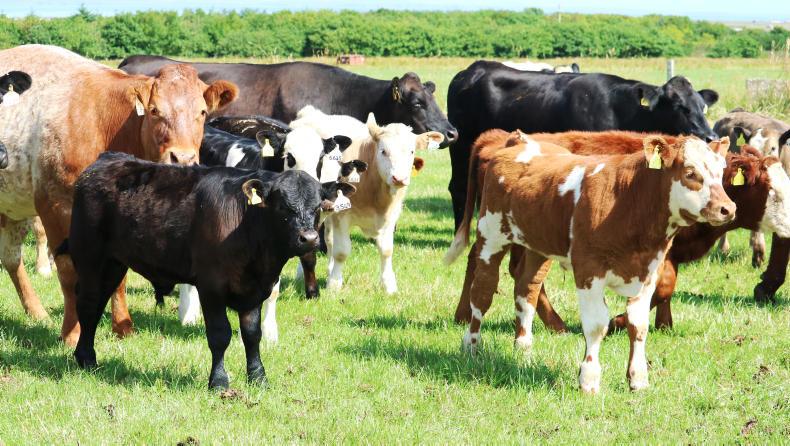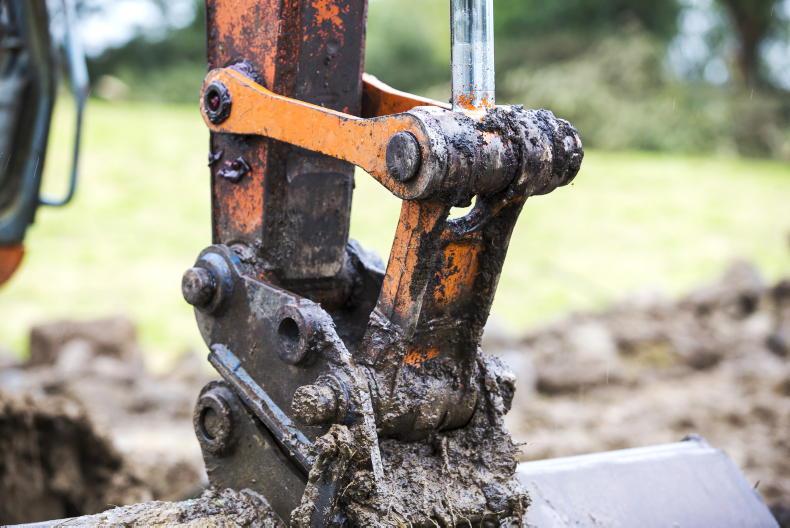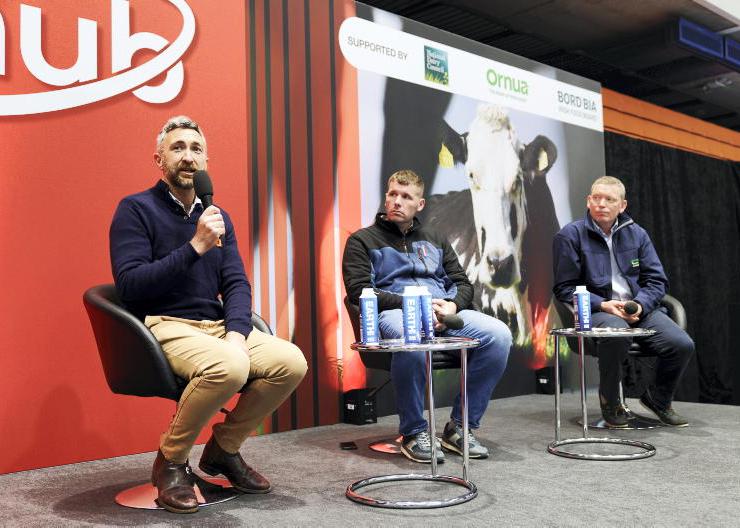In January 2017 the Farmers Journal together with Aberdeen and Northern Marts, launched the Farm Profit Programme in the northeast of Scotland. The programme, similar to the BETTER farm programme in Ireland is comprised of six focus farms in the greater Aberdeenshire area. Over the past 20 months the farms have been addressing issues on their farms to help improve overall farm profitability.
Some aspects of farming in the north-east of Scotland are very different to Ireland – farm size of the six focus farms ranges from just over 300ac to a 3,000-acre hill unit, with the average somewhere just over the 600ac mark. The average herd size is 120 cows with four of the six farms also having a sheep enterprise with an average flock size of 360 ewes.
When the farms were benchmarked at the beginning of the project, the average gross margin (GM) per cow sat at £346 (€386) while GM/ewe was £43 (€48). The programme has set targets of £750GM/cow (€838) and £100GM/ewe (€112). The first year results showed an increase of £115GM/cow (€128) and £3GM/ewe (€3.35). 
For this project, everything is benchmarked on a per-head basis rather than on a per-hectare basis as would be the norm in Ireland. The reason for this is that in many cases, land is not the first limiting factor on a lot of these farms. More typically, the first limiting factor is either labour or winter accommodation.
That’s not to say that access to land is not an issue for many young farmers trying to get a foothold in an industry that is crying out for young blood and fresh ideas.
Digging deeper to reveal some of the reasons behind the low profitability, you begin to see many similarities to Ireland.
Productivity of the beef herd is similar with 84 calves weaned for every 100 cows to the bull. The main issues here are around not culling hard enough, bulls not being removed from cows quick enough and allowing cows to slip from spring to autumn herds and vice versa.
Soil
Soil health is another problem with many of the farms needing to address soil fertility and drainage. With a greater number of acres to look after, this leaves farmers with less time to spend on each acre.
Often this leads to a concentration on the better, more productive land with poorer parts of the farm left unproductive. There is huge potential here to increase farm profitability by bringing this ground back into production.
Each of the farms now has a soil fertility plan in place for the next number of years. They are refocusing on liming ground to address soil pH deficiencies, correcting soil P and K levels and improving soil drainage and aeration.
Prior to the long dry summer experienced this year, Scotland had endured a number of poor years weather wise meaning fieldwork, carried out by larger and larger equipment all the time, was being done in sub-optimal conditions.

Cow and calves grazing on the farm of FPP farmer Andrew Gammie in Laurencekirk, between Aberdeen and Dundee.
Soil compaction has become a problem on many farms as a result.
With larger farm sizes come larger fields, with 30-50ac fields not uncommon. Unfortunately, these do not lend themselves to rotational grazing quite easily.
While many farmers have embraced rotational grazing and are getting great results by doing so, it would not be commonplace. Set stocking is more typical, with a bulling group of 35-40 cows per field.
Much of this ground will be in a crop rotation with many farms growing barley for winter feed and bedding as the majority of cattle are wintered on straw-bedded courts.
This means some farmers are reluctant to split large fields up with electric fences as they will be pulling them out every five to seven years. Water availability also becomes an issue.
Set stocking straight away lowers the potential output from the ground as estimated annual herbage yields linger around 4-5tDM/ha.
Although it is much more northerly than Ireland, Scotland still has the ability to grow a large amount of grass where management is correct.
One of the focus farms grew over 12tDM/ha in the first year of the project, rotationally grazing ewes and lambs, with room for further improvement on this.

Daylight
One disadvantage compared to Ireland is that the shoulders of the year are that bit narrower in terms of grass growth, making early spring grazing a difficulty as ground is slow to heat up due to cooler temperatures and shorter daylight hours.
During the summer months is where Scotland can really excel in terms of grass growth.
Caithness for example (the most northerly point of mainland UK) can experience close to 20 hours of daylight during the summer.
This means the grass growth curve has a higher peak but tails off earlier at both ends of the year compared to the Ireland.
All of this leads to a long winter period – 200 days is not uncommon. It is here that the greatest burden as well as opportunity lies for the Scottish beef industry.
With indoor feed and bedding costs estimated to be in excess of £2/cow/day (€2.24) this winter, with bedding costs alone accounting for about £0.60/head/day (€0.67), slats and cubicles or out-wintering are going to have to be considered going forward.
Out-wintering is a viable option on the eastern side of the country with typical annual rainfall levels around 800mm.
Due to the poor yields of spring barley this year there has been a renewed interest in forage crops. Even if it cannot eliminate the entire winter, reducing the number of days cows spend in the shed will have a massive impact on farm profitability.
Drought
Scotland has experienced a similar summer to Ireland with silage yields for first cut back between 30-50% in places. Second cut yields were variable too, however many farms had closed up a larger area than normal for second cut to alleviate yield shortages with a lot of crops yet to be harvested. Since late July, many areas have been getting sufficient rainfall to boost grass growth with the countryside looking greener now than it has done all year.
The biggest issue for livestock farmers is the cost of straw this winter.
While winter crops have done well in most cases with good straw yields, spring barley crops have yielded very poorly with straw yields well back on previous years.
On some really light land spring barley was mowed and put in the pit as it wasn’t seen to be fit to combine.This has left straw prices elevated with 4×4 rounds trading at £15-£18 (€16.75-€20) in the field, a 50% increase on last year in some instances.
Steer deadweight price (R4L): £3.83=€4.23. Cow deadweight price (O+4L): £2.69=€2.97.Lamb price (R3L): £4.35=€4.81.Tonne of Nitrogen (34.5%N): £235 =€260.Weanling ration: £230=€254.Barley off the combine: £170=€188.4×4 bale of straw: £18=€20.*exchange rate at €1=£0.905
In January 2017 the Farmers Journal together with Aberdeen and Northern Marts, launched the Farm Profit Programme in the northeast of Scotland. The programme, similar to the BETTER farm programme in Ireland is comprised of six focus farms in the greater Aberdeenshire area. Over the past 20 months the farms have been addressing issues on their farms to help improve overall farm profitability.
Some aspects of farming in the north-east of Scotland are very different to Ireland – farm size of the six focus farms ranges from just over 300ac to a 3,000-acre hill unit, with the average somewhere just over the 600ac mark. The average herd size is 120 cows with four of the six farms also having a sheep enterprise with an average flock size of 360 ewes.
When the farms were benchmarked at the beginning of the project, the average gross margin (GM) per cow sat at £346 (€386) while GM/ewe was £43 (€48). The programme has set targets of £750GM/cow (€838) and £100GM/ewe (€112). The first year results showed an increase of £115GM/cow (€128) and £3GM/ewe (€3.35). 
For this project, everything is benchmarked on a per-head basis rather than on a per-hectare basis as would be the norm in Ireland. The reason for this is that in many cases, land is not the first limiting factor on a lot of these farms. More typically, the first limiting factor is either labour or winter accommodation.
That’s not to say that access to land is not an issue for many young farmers trying to get a foothold in an industry that is crying out for young blood and fresh ideas.
Digging deeper to reveal some of the reasons behind the low profitability, you begin to see many similarities to Ireland.
Productivity of the beef herd is similar with 84 calves weaned for every 100 cows to the bull. The main issues here are around not culling hard enough, bulls not being removed from cows quick enough and allowing cows to slip from spring to autumn herds and vice versa.
Soil
Soil health is another problem with many of the farms needing to address soil fertility and drainage. With a greater number of acres to look after, this leaves farmers with less time to spend on each acre.
Often this leads to a concentration on the better, more productive land with poorer parts of the farm left unproductive. There is huge potential here to increase farm profitability by bringing this ground back into production.
Each of the farms now has a soil fertility plan in place for the next number of years. They are refocusing on liming ground to address soil pH deficiencies, correcting soil P and K levels and improving soil drainage and aeration.
Prior to the long dry summer experienced this year, Scotland had endured a number of poor years weather wise meaning fieldwork, carried out by larger and larger equipment all the time, was being done in sub-optimal conditions.

Cow and calves grazing on the farm of FPP farmer Andrew Gammie in Laurencekirk, between Aberdeen and Dundee.
Soil compaction has become a problem on many farms as a result.
With larger farm sizes come larger fields, with 30-50ac fields not uncommon. Unfortunately, these do not lend themselves to rotational grazing quite easily.
While many farmers have embraced rotational grazing and are getting great results by doing so, it would not be commonplace. Set stocking is more typical, with a bulling group of 35-40 cows per field.
Much of this ground will be in a crop rotation with many farms growing barley for winter feed and bedding as the majority of cattle are wintered on straw-bedded courts.
This means some farmers are reluctant to split large fields up with electric fences as they will be pulling them out every five to seven years. Water availability also becomes an issue.
Set stocking straight away lowers the potential output from the ground as estimated annual herbage yields linger around 4-5tDM/ha.
Although it is much more northerly than Ireland, Scotland still has the ability to grow a large amount of grass where management is correct.
One of the focus farms grew over 12tDM/ha in the first year of the project, rotationally grazing ewes and lambs, with room for further improvement on this.

Daylight
One disadvantage compared to Ireland is that the shoulders of the year are that bit narrower in terms of grass growth, making early spring grazing a difficulty as ground is slow to heat up due to cooler temperatures and shorter daylight hours.
During the summer months is where Scotland can really excel in terms of grass growth.
Caithness for example (the most northerly point of mainland UK) can experience close to 20 hours of daylight during the summer.
This means the grass growth curve has a higher peak but tails off earlier at both ends of the year compared to the Ireland.
All of this leads to a long winter period – 200 days is not uncommon. It is here that the greatest burden as well as opportunity lies for the Scottish beef industry.
With indoor feed and bedding costs estimated to be in excess of £2/cow/day (€2.24) this winter, with bedding costs alone accounting for about £0.60/head/day (€0.67), slats and cubicles or out-wintering are going to have to be considered going forward.
Out-wintering is a viable option on the eastern side of the country with typical annual rainfall levels around 800mm.
Due to the poor yields of spring barley this year there has been a renewed interest in forage crops. Even if it cannot eliminate the entire winter, reducing the number of days cows spend in the shed will have a massive impact on farm profitability.
Drought
Scotland has experienced a similar summer to Ireland with silage yields for first cut back between 30-50% in places. Second cut yields were variable too, however many farms had closed up a larger area than normal for second cut to alleviate yield shortages with a lot of crops yet to be harvested. Since late July, many areas have been getting sufficient rainfall to boost grass growth with the countryside looking greener now than it has done all year.
The biggest issue for livestock farmers is the cost of straw this winter.
While winter crops have done well in most cases with good straw yields, spring barley crops have yielded very poorly with straw yields well back on previous years.
On some really light land spring barley was mowed and put in the pit as it wasn’t seen to be fit to combine.This has left straw prices elevated with 4×4 rounds trading at £15-£18 (€16.75-€20) in the field, a 50% increase on last year in some instances.
Steer deadweight price (R4L): £3.83=€4.23. Cow deadweight price (O+4L): £2.69=€2.97.Lamb price (R3L): £4.35=€4.81.Tonne of Nitrogen (34.5%N): £235 =€260.Weanling ration: £230=€254.Barley off the combine: £170=€188.4×4 bale of straw: £18=€20.*exchange rate at €1=£0.905














SHARING OPTIONS